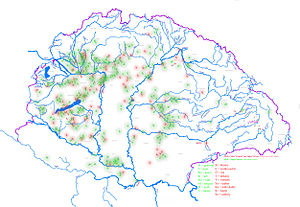- Magyar tribes
-
The Magyar tribes (Hungarian: magyar törzsek) were the fundamental political units whose framework the Hungarians (Magyars) lived within, until these clans from Asia, more accurately from the region of Ural Mountains,[1] invaded the Carpathian Basin and established the Principality of Hungary.[2][unreliable source?][3][verification needed]
The locality in which the Hungarians, the Manicha-Er group, emerged was between the Volga river and the Ural Mountains.[1] Between the 8th and 5th centuries BC, the Magyars embarked upon their independent existence and the early period of the proto Magyar language began.[1]
Around 830,[4][5] the seven related tribes (Jenő, Kér, Keszi, Kürt-Gyarmat, Megyer, Nyék and Tarján)[6] formed a confederation[4] in Etelköz,[5] called "Hétmagyar" (ie, "The Seven Magyars"). Their leaders, the Seven chieftains of the Magyars, besides Álmos included Előd, Ond, Kond, Tas, Huba and Töhötöm, took a blood oath, swearing eternal loyalty to Álmos.[7] Presumably, the Magyar tribes consisted of 108 clans.[8]The confederation of the tribes was probably led by two high princes: the kende (their spiritual ruler) and the gyula (their military leader). The high princes were either elected by the leaders of the tribes or appointed by the Khagan of the Khazars who had been exerting influence over the Magyars. Around 862 the seven tribes separated from the Khazars.
Before 881 three Turkic tribes rebelled against the rule of the Khagan of the Khazars, but they were suppressed. After their defeat they left the Khazar Empire and joined voluntarily to the confederation Hétmagyar. The three tribes was organised into one tribe, called Kabar, and later they played the role of vanguard and rear guard during the joint military actions of the confederation. With the joining of the three tribes to the previous seven ones, they became ten, which made them On-ogur (Ten Arrows),[6] one of the possible origins for the name Hungarian.[clarification needed]
Sources
- Korai Magyar Történeti Lexikon (9-14. század), főszerkesztő: Kristó, Gyula, szerkesztők: Engel, Pál és Makk, Ferenc (Akadémiai Kiadó, Budapest, 1994)
- Kristó, Gyula: A Kárpát-medence és a magyarság régmúltja (1301-ig) (Szegedi Középkortörténeti Könyvtár, Szeged, 1993)
- Magyarország Történeti Kronológiája I. – A kezdetektől 1526-ig, főszerkesztő: Benda Kálmán (Akadémiai Kiadó, Budapest, 1981)
References
- ^ a b c András Róna-Tas, Hungarians and Europe in the early Middle Ages: an introduction to early Hungarian history, Central European University Press, 1999, p. 319
- ^ George H. Hodos, The East-Central European region: an historical outline, Greenwood Publishing Group, 1999, p. 19
- ^ S. Wise Bauer, The history of the medieval world: from the conversion of Constantine to the First Crusade, W. W. Norton & Company, 2010, p. 586
- ^ a b Carl Waldman, Catherine Mason, Encyclopedia of European peoples, Volume 1, Infobase Publishing, 2006, p. 508
- ^ a b Paul Lendvai, The Hungarians: a thousand years of victory in defeat, C. Hurst & Co. Publishers, 2003, p. 15-29, p. 533
- ^ a b Kevin Alan Brook, The Jews of Khazaria, Rowman & Littlefield, 2009, pp. 163-164.
- ^ http://www.kislexikon.hu/hetmagyar.html (Hungarian)
- ^ John P. C. Matthews, Explosion: the Hungarian Revolution of 1956, Hippocrene Books, 2007, p. 69
Categories:
Wikimedia Foundation. 2010.

